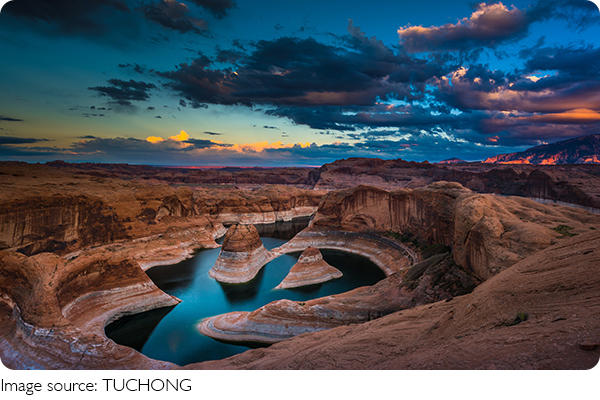Grand Canyon Guide

If you've ever looked at a photo of the Grand Canyon and thought, "It can't really look like that in real life," here's the truth: it looks even better.
But this massive natural wonder can also be overwhelming without a plan. Where should you go for the best view? Which trail is right for your fitness level? And what's the deal with those shuttle buses?
This guide breaks it all down—so whether you're coming for a day or a weekend, you'll know how to see the best of the Grand Canyon without wasting time or energy.
Understanding the Park: South Rim vs. North Rim
The Grand Canyon National Park is divided into two main visitor areas:
1. South Rim: Open year-round and home to most viewpoints, shuttle routes, and tourist facilities. This is the best choice for first-time visitors.
2. North Rim: Higher in elevation, quieter, and only open mid-May to mid-October. Great for experienced hikers or those seeking solitude.
This article focuses on the South Rim, where 90% of travelers go.
Entry Fees and Hours
Park entrance fee:
• Private vehicle: $35 per car (valid for 7 days)
• Motorcycle: $30
• Individual (on foot or bike): $20
The park is open 24 hours a day, 365 days a year, though certain facilities follow seasonal hours.
Pro tip: If you plan to visit 3 or more U.S. national parks in a year, consider the America the Beautiful Pass for $80/year.
Getting There and Around
1. By car: Most visitors drive to the South Rim. From Flagstaff, AZ, it's about 1.5 hours (80 miles). From Arizona’s capital, it's 3.5–4 hours.
2. By train: The Grand Canyon Railway runs from Williams, AZ to the South Rim and offers a vintage, scenic ride (tickets from $70 round trip).
3. Free shuttle buses: Once inside the park, you can rely on the free shuttle system to explore without driving. No ticket is required.
Using the Free Shuttle System
There are four main shuttle routes (color-coded), all operating from March to late November:
1. Village Route (Blue): Connects the visitor center, lodges, and Market Plaza—great for navigating Grand Canyon Village.
2. Kaibab Rim Route (Orange): Access to Yaki Point and South Kaibab Trailhead—ideal for sunrise views and short hikes.
3. Hermit Road Route (Red): Open to buses only. Stops at some of the best overlooks, like Hopi Point and Hermit's Rest.
4. Tusayan Route (Purple): Operates in peak season from the nearby town of Tusayan—useful if you're staying outside the park.
Shuttles come every 10–15 minutes. You can hop on and off at any stop.
Best Scenic Viewpoints on the South Rim
Here are the top five must-see viewpoints (from easiest to reach to slightly further out):
1. Mather Point: Right by the Visitor Center. Crowded, but iconic. Come early or late for less foot traffic.
2. Yaki Point: Accessible only by shuttle or foot. Offers a quieter view and great light at sunrise.
3. Hopi Point: Best known for sunset views—wide canyon vistas and deep shadows.
4. Grandview Point: A short drive or shuttle ride away, offering dramatic views and access to longer hikes.
5. Desert View: 25 miles east of the Village. Includes the historic Watchtower and views of the Colorado River.
Beginner-Friendly Hiking Trails
Not all Grand Canyon hikes are strenuous! Here are beginner-friendly options that still deliver on scenery:
1. Rim Trail: Flat and paved in many sections, this trail runs for 13 miles along the edge. You can walk a segment between shuttle stops.
2. Bright Angel Trail (to 1.5 Mile Resthouse): Descend into the canyon for a taste of hiking below the rim. It's about 3 miles round-trip and can be completed in 1.5–2 hours.
3. South Kaibab Trail (to Ooh Aah Point): A short, steep descent with a big view payoff—just 1.8 miles round-trip. Perfect for sunrise hikers.
Always carry water, wear sturdy shoes, and avoid hiking into the canyon during midday heat (especially in summer).
Where to Eat and Stay
Inside the park:
1. El Tovar Dining Room: Historic setting with full meals (book ahead). Great for a relaxed dinner.
2. Bright Angel Restaurant: Family-friendly with casual options like sandwiches, pasta, and salads.
Nearby towns:
Tusayan (just outside the park's south entrance) has several options including fast food, diners, and the popular We Cook Pizza and Pasta.
Accommodation:
1. El Tovar Hotel: Luxury stay inside the park, right on the rim. Rooms from $250+. Book months ahead.
2. Yavapai Lodge: Mid-range option near Market Plaza. Comfortable and convenient (starting at $170/night).
3. Red Feather Lodge (Tusayan): Budget-friendly and shuttle accessible. Around $120–150/night.

Tips for First-Time Visitors
1. Arrive early or stay late—Sunrise and sunset are quieter and more beautiful.
2. Dress in layers—Even in summer, mornings can be chilly and afternoons hot.
3. Carry refillable water bottles—There are free refill stations across the park.
4. Don't try to "see it all" in one day—Stick to 2–3 viewpoints and one short hike.
So, What's Your Canyon Style?
Are you a sunrise hiker? A shuttle explorer? Or the type who wants to stare at the canyon with a sandwich in hand? Whatever your style, the Grand Canyon has a way of surprising you. The key is to plan a little, slow down, and let the views work their magic.
Already been? Planning a future trip? Drop your questions—whether it's about the best shuttle stop or where to find the quietest viewpoint, I'm happy to help tailor your visit.

 · Travel Team
· Travel Team